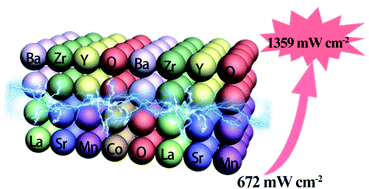Triggering interfacial activity of the traditional La0.5Sr0.5MnO3 cathode with Co-doping for proton-conducting solid oxide fuel cells†
Abstract
Doping the La0.5Sr0.5MnO3−δ (LSM) cathode with the Co element allows the new material La0.5Sr0.5Mn0.9Co0.1O3−δ (LSMCo) to show improved performance compared with the Co-free LSM for proton-conducting solid oxide fuel cells (H-SOFCs), demonstrated by both experiments and first-principles calculations. More importantly, doping Co into LSM triggers the activity of the cathode/electrolyte interface in the composite cathode, leading to an impressively high fuel cell performance of the cell using the LSMCo composite cathode and also revealing the importance of the interfacial design for the cathode of H-SOFCs.

- This article is part of the themed collections: 2023 Journal of Materials Chemistry A Lunar New Year collection and 2022 Journal of Materials Chemistry A Most Popular Articles


 Please wait while we load your content...
Please wait while we load your content...